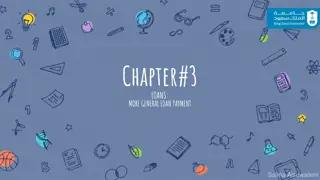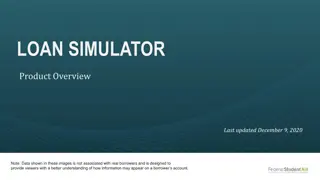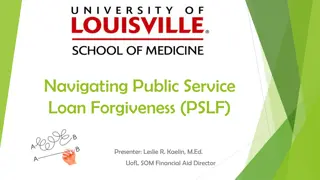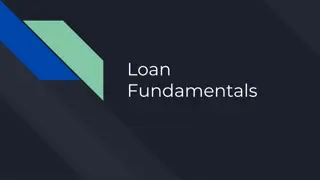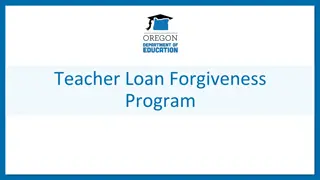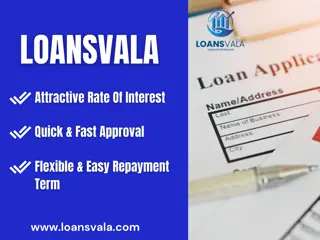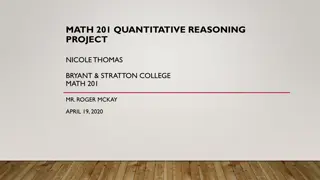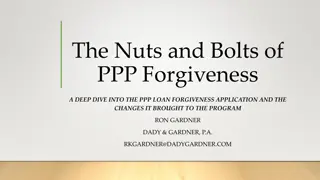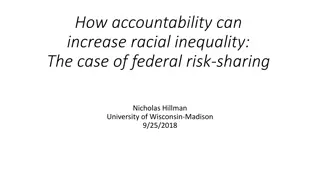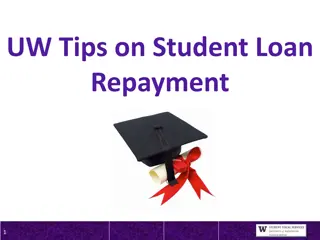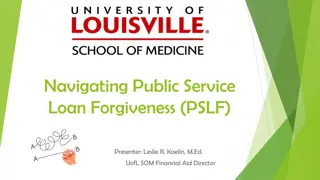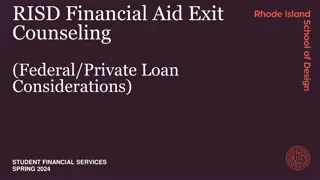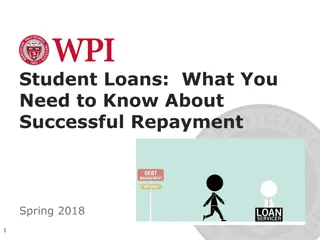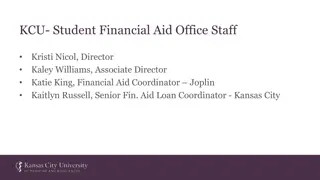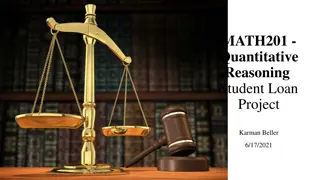Understanding Federal Student Loan Repayment and Forgiveness Programs
Discover important information about federal student loan repayment and forgiveness options, including when repayment begins, different repayment plan types like the Standard 10-Year Plan, Income-Based Repayment Plan (IBR), and Pay As You Earn (PAYE) Repayment Plan, along with details on loan forgiveness opportunities. Get insights on managing student debt effectively.
Download Presentation

Please find below an Image/Link to download the presentation.
The content on the website is provided AS IS for your information and personal use only. It may not be sold, licensed, or shared on other websites without obtaining consent from the author. Download presentation by click this link. If you encounter any issues during the download, it is possible that the publisher has removed the file from their server.
E N D
Presentation Transcript
Federal Student Loan Repayment and Forgiveness Ms. Ellen M. Gomes Director of Medical Student Financial Aid
Agenda 1. When Repayment of Federal Student Loans Begins 2. Different Repayment Plan Types 3. The MedLOANS Organizer & Calculator 4. Loan Repayment Examples 5. Status of Federal Student Debt Relief Plan 6. Student Loan Repayment and Interest Accrual Pause 7. Questions
When does Repayment Begin? Repayment of Federal Student Loans begins after your six month grace period, which begins after you graduate or stop attending school at least half-time. If you graduate in April, repayment should begin in or near October, and if you graduate in May repayment should begin in or near November
When does Repayment Begin (cont.)? If you previously entered repayment on any Federal student loan(s), those loans do not have a new six month grace period. They will reenter repayment once you graduate. If you do not want to make payment on any of your loans until after your new loans six month grace period, you will need to request forbearance for the loans without a grace period. This may be done through your loan servicer or at studentaid.gov
Standard 10 Year Plan (The Default Plan) The default plan if you do not select an income based plan Payment is the monthly amount required to repay the loan in full after 10 years
Income Based Repayment Plan (IBR) A 25 Year Plan Payment is 10% of Discretionary Income (Your income less 150% of the poverty guideline for a HH your size) for new borrowers as of 7/1/14; or 15% of Discretionary Income for borrowers who had outstanding Federal student loan debt on 7/1/14, up to the payment cap of the 10 year plan payment amount Any balance due after 25 years of payments is forgiven, and the forgiven amount is taxable income to you in the year it is forgiven Public Service Loan Forgiveness available for any balance due after you have made 120 on-time payments while employed by a qualifying non- profit employer. The forgiven amount is not treated as taxable income
Pay As You Earn (PAYE) Repayment Plan A 20 Year Plan Payment is 10% of discretionary income (your income less 150% of the poverty guideline for a HH your size), up to the payment cap of the 10 Year plan payment amount Any balance due after 20 years of payments is forgiven, and the forgiven amount is taxable income to you in the year it is forgiven Public Service Loan Forgiveness available for any balance due after you have made 120 on-time payments while employed by a qualifying non-profit employer. The forgiven amount is not treated as taxable income
Revised Pay As You Earn (REPAYE) Repayment Plan A 25 Year Plan Payment is 10% of Discretionary Income (Your income less 150% of the poverty guideline for a HH your size (There is no payment cap in this plan) If your monthly interest accrual is greater than your payment amount, half of the difference between the two is immediately forgiven. This will normally result in a smaller balance due after residency than if you used the IBR or PAYE plan, as not all accrued interest is added to your balance due Any balance due after 25 years of payments is forgiven, and the forgiven amount is taxable income to you in the year it is forgiven Public Service Loan Forgiveness available for any balance due after you have made 120 on-time payments while employed by a qualifying non-profit employer. The forgiven amount is not treated as taxable income
MedLoans Organizer and Calculator (MLOC) The MLOC is found on the AAMC website. You can download your student loan data from studentaid.gov and upload it into the organizer. Once you have done that, you will go to the calculator. First you will estimate the length of residency/fellowship, estimated residency and 1st year in practice salaries, and then you can view estimated payment amounts in the various payment plans
Federal Student Loan Debt Relief Plan Student Debt Relief is currently blocked Courts have issued orders blocking the program, and we are waiting on the Supreme Court to make the final decision. Eligible Loans: 1. William D. Ford Direct Loans (Direct Loans) 2. Federal Family Education Loans (FFEL Loans) held by the Department of Education (ED) 3. Federal Perkins Loan held by ED 4. Defaulted Loans held by ED *Applies only to loan balances you had before June 30, 2022*
Federal Student Loan Debt Relief (Cont.) Amount(s) to be Forgiven 1. Up to $20,000 if you received a Federal Pell Grant in College and meet the income requirements 2. Up to $10,000 If you did not receive a Federal Pell Grant in College and meet the income requirements 3. Forgiven amounts are not taxed at the Federal level, but some states have said they will be taxed at the state level. 4. Only outstanding balances due may be forgiven. If you only owe $5,000, then that is the maximum that can be forgiven.
Federal Student Loan Debt Relief (Cont.) Refunds for Past Payments From ED: If you made voluntary payments during the payment pause and your current loan balance is below the amount of debt relief you ll receive, after you successfully apply for and receive debt relief under the Administration's debt relief plan, we ll automatically refund the amount you paid during the payment pause (only up to the remaining amount of your eligible debt relief).
Income Requirements to Qualify for Federal Student Loan Debt Relief Tax Filing Status 2020 or 2021 Income (AGI) Made less than required to file Under $125,000 Under $125,000 Under $250,000 Under $250,000 Under $250,000 Did not file Taxes Single Married Filing Separately Married Filing Jointly Head of Household Qualifying Widow(er)
Federal Student Loan Payment and Interest Accrual Pause When Repayment is Scheduled to Restart The current Payment pause is scheduled to end on June 30, 2023 or when the Supreme Court issues its decision regarding Federal Student Loan Debt Relief, whichever is earlier. Interest on Federal Student Loans is scheduled to begin/restart accruing on all disbursed funds at the end of the payment pause
To Receive Updates on Federal Student Loan Debt Relief From ED: Subscribe and check back here for updates. The Website is: https://www.ed.gov/subscriptions We will also post information as soon as further updates are available. Please contact your Financial Aid Office for questions about your individual situations.



